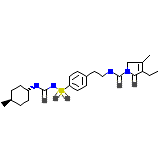Glimepiride




Glimepiride Brand names, Glimepiride Analogs
Glimepiride Brand Names Mixture
- No information avaliable
Glimepiride Chemical_Formula
Glimepiride RX_link
Glimepiride fda sheet
Glimepiride msds (material safety sheet)
Glimepiride Synthesis Reference
Glimepiride Molecular Weight
Glimepiride Melting Point
Glimepiride H2O Solubility
Glimepiride State
Glimepiride LogP
Glimepiride Dosage Forms
Glimepiride Indication
Glimepiride Pharmacology
Glimepiride Absorption
Glimepiride side effects and Toxicity
Glimepiride Patient Information
Patients should be informed of the potential risks and advantages of AMARYL and of alternative modes of therapy. They should also be informed about the importance of adherence to dietary instructions, of a regular exercise program, and of regular testing of blood glucose.
The risks of hypoglycemia, its symptoms and treatment, and conditions that predispose to its development should be explained to patients and responsible family members. The potential for primary and secondary failure should also be explained.
|
Here are some common questions concerning Amaryl and its use in managing diabetes.
What is Amaryl? Amaryl (pronounced AM-a-rill) is a type of diabetes medication called a sulfonylurea (sull-fon-ill-u-REE-ah). Doctors have been prescribing sulfonylureas for more than 40 years.Amaryl is a sulfonylurea for patients with type 2 diabetes and can be used along with proper diet and exercise when diet and exercise are not enough. In addition, Amaryl may be used in combination with insulin or metformin (another type of diabetes medication) when diet, exercise, and Amaryl or metformin alone are not enough to lower your blood glucose (sugar) levels. When used in combination with insulin, Amaryl may reduce the amount of insulin needed. Taking Amaryl and metformin or insulin in combination may increase the potential for blood glucose levels to be too low. How Does Amaryl Work? Amaryl works primarily to correct insulin deficiency. When your body doesn't have enough insulin, it can't carry glucose out of the bloodstream and into the cells. Amaryl helps your body produce extra insulin when it is needed (after meals), so it can carry glucose into your cells to be converted into energy. Amaryl may also make tissues in your muscles and other organs more sensitive to insulin.How Often is Amaryl Taken? You need to take Amaryl only once a day with the first main meal. It is important to keep getting your prescription refilled and taking Amaryl, unless your doctor gives you other instructions.Why Did the Doctor Choose Amaryl? Your doctor probably chose Amaryl for several reasons. Amaryl is an effective medication that needs to be taken only once a day, which makes it more convenient for you to fit into your schedule. And, if you inject insulin, Amaryl can reduce the amount of insulin you need.Does Amaryl Have Any Side Effects? In clinical studies, the most common side effects with Amaryl are blood sugar levels that are too low (0.9% to 1.7%), dizziness (1.7%), weakness (1.6%), headache (1.5%), and nausea (1.1%). As with other drugs similar to Amaryl, there is a possibility of experiencing blood sugar levels that are severely low.Taking Amaryl and metformin or insulin in combination may increase the potential for blood glucose levels to be too low. Patients with impaired kidney function should be started on a lower dose because of the increased potential for blood sugar levels to be too low. How Long Should Amaryl Be Taken? You will need to take Amaryl until your doctor tells you otherwise. Keep getting your prescriptions refilled and taking Amaryl unless your doctor gives you different instructions.Can Amaryl Be Taken With Other Medications? Many medications can be taken with Amaryl. You should always talk with your doctor about all the prescription and over-the-counter medications and dietary supplements you are taking before starting a new prescription.Can Amaryl Be Taken During Pregnancy? Amaryl should not be used during pregnancy. Women taking Amaryl who suspect that they are pregnant should contact their doctor immediately. |














